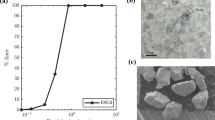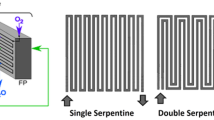Abstract
This work analyses the measure of fit of experimental data of permeate flux decline with time for ultrafiltration experiments performed with polyethylene glycol aqueous solutions to two different ultrafiltration models. A feed solution of 5 kg/m\(^{3}\) of polyethylene glycol and a monotubular ceramic membrane of \({\mathrm{ZrO}}_{2}\)–\({\mathrm{TiO}}_{2}\) were used in the experiments. The first model considered was developed by Ho and Zydney and it considers two different fouling mechanisms: pore blocking and gel layer formation. The second model was proposed by Yee et al. It is an exponential model that considers three stages: concentration polarization, molecule deposition on the membrane surface and long-term fouling. The results show that both models give very accurate predictions for the severe fouling conditions (high transmembrane pressures and low crossflow velocities). However, both models cannot explain the experimental results obtained for all the experimental conditions tested. An equation for Ho and Zydney’s model parameters as a function of operating conditions was obtained by means of multiple regression analysis.






Similar content being viewed by others
Abbreviations
- \(A\) :
-
Transport area (\({\mathrm{m}}^{2}\))
- \(A_\mathrm{agg}\) :
-
Membrane area blocked by a single aggregate (\({\mathrm{m}}^{2}\))
- \(A_\mathrm{open}\) :
-
Region of membrane area with open pores (\({\mathrm{m}}^{2}\))
- \(A_\mathrm{blocked}\) :
-
Region of membrane area with partially blocked pores (\({\mathrm{m}}^{2}\))
- \(A_\mathrm{m}\) :
-
Membrane area (\({\mathrm{m}}^{2}\))
- \(B\) :
-
Constant in complete blocking law (\({\mathrm{s}}^{-1}\))
- \(b_\mathrm{f}\) :
-
Rate constant for the decrease in flux decline in each stage of fouling (\({\mathrm{s}}^{-1}\))
- \(C\) :
-
Constant in standard blocking law (\({\mathrm{s}}^{-1}\))
- \(C_\mathrm{b}\) :
-
Bulk concentration (\({\mathrm{kg}}/{\mathrm{m}}^{3}\))
- \(C_\mathrm{g}\) :
-
Gel concentration (\({\mathrm{kg}}/{\mathrm{m}}^{3}\))
- \(C_\mathrm{p}\) :
-
Permeate concentration (\({\mathrm{kg}}/{\mathrm{m}}^{3}\))
- \(D\) :
-
Particle diffusion coefficient
- \(f\) :
-
Fractional amount of the total solute present as aggregate (dimensionless)
- \(f^{\prime }\) :
-
Fractional amount of the total solute that contributes to the deposit growth (dimensionless)
- \(J\) :
-
Permeate flux (\({\mathrm{m}}^{3}/{\mathrm{m}}^{2}\,{\mathrm{s}}\))
- \({\overline{J}}\) :
-
Average permeate flux (\({\mathrm{m}}^{3}/{\mathrm{m}}^{2}\,{\mathrm{s}})\)
- \(J_\mathrm{eq }\) :
-
Local equilibrium permeate flux (\({\mathrm{m}}^{3}/{\mathrm{m}}^{2}\,{\mathrm{s}})\)
- \(J_\mathrm{open}\) :
-
Permeate flux through the open pores (\({\mathrm{m}}^{3}/{\mathrm{m}}^{2}\,{\mathrm{s}})\)
- \(J_\mathrm{blocked }\) :
-
Permeate flux trough the partially blocked pores (\({\mathrm{m}}^{3}/{\mathrm{m}}^{2}\,{\mathrm{s}})\)
- \(J_{0}\) :
-
Initial permeate flux (\({\mathrm{m}}^{3}/{\mathrm{m}}^{2}\,{\mathrm{s}})\)
- \(J_{\infty }\) :
-
Steady-state permeate flux (\({\mathrm{m}}^{3}/{\mathrm{m}}^{2}\,{\mathrm{s}})\)
- \(J_\mathrm{w }\) :
-
Deionized water flux (\({\mathrm{m}}^{3}/{\mathrm{m}}^{2}\,{\mathrm{s}})\)
- \(k_\mathrm{b}\) :
-
Back-transport coefficient
- \(k_\mathrm{f}\) :
-
Exponential factor for each stage of fouling (\({\mathrm{m}}^{3}/{\mathrm{m}}^{2}\,{\mathrm{s}})\)
- \(L\) :
-
Membrane length (m)
- \(M_\mathrm{agg }\) :
-
Mass of a single aggregate (kg)
- \(P_\mathrm{m}\) :
-
Permeability coefficient
- \(\Delta P\) :
-
Transmembrane pressure (MPa)
- \(Q_\mathrm{open}\) :
-
Volumetric permeate flow rate through open pores \(({\mathrm{m}}^{3}/{\mathrm{s}})\)
- \(Q_\mathrm{blocked}\) :
-
Volumetric permeate flow rate through partially blocked pores (\({\mathrm{m}}^{3}/{\mathrm{s}})\)
- \(R_\mathrm{a}\) :
-
Resistance of the irreversible adsorbed protein deposit (\({\mathrm{m}}^{-1}\))
- \(R_\mathrm{m }\) :
-
Resistance of the clean membrane (\({\mathrm{m}}^{-1}\))
- \(R_\mathrm{p}\) :
-
Resistance of the solute deposit (\({\mathrm{m}}^{-1}\))
- \(R_\mathrm{p0}\) :
-
Resistance of a single solute aggregate (\({\mathrm{m}}^{-1}\))
- \(R^{\prime }\) :
-
Specific layer resistance (m/kg)
- \(t\) :
-
Filtration time (s)
- \(t_{1}\) :
-
Transition time between fouling stages 1 and 2 (s)
- \(t_{2}\) :
-
Transition time between fouling stages 2 and 3 (s)
- \(t_\mathrm{ss}\) :
-
Steady-state time (s)
- \(V\) :
-
Total volume collected (\({\mathrm{m}}^{3}\))
- \(x\) :
-
Distance from the membrane entrance (m)
- \(\alpha \) :
-
Pore blockage parameter (\({\mathrm{m}}^{2}/{\mathrm{kg}}\))
- \(\beta \) :
-
Fraction of pores susceptible to be completely blocked (dimensionless)
- \(\gamma \) :
-
Shear rate
- \(\mu \) :
-
Feed solution viscosity (\({\mathrm{kg}}/ {\mathrm{m}}/{\mathrm{s}})\)
- \(\sigma \) :
-
Rejection
- \(\omega \) :
-
Angular velocity (\({\mathrm{rad}}/{\mathrm{s}}\))
- \(\Delta \pi \) :
-
Osmotic pressure
- UF:
-
Ultrafiltration
- PEG:
-
Polyethylene glycol
- MRA:
-
Multiple regression analysis
References
Alventosa-deLara, E., Barredo-Damas, S., Alcaina-Miranda, M.I., Iborra-Clar, M.I.: Ultrafiltration technology with a ceramic membrane for reactive dye removal: optimization of membrane performance. J. Hazard. Mater. 209–210, 492–500 (2012)
Baldasso, C., Barros, T.C., Tessaro, I.C.: Concentration and purification of whey proteins by ultrafiltration. Desalination 278, 381–386 (2011)
Bhattacharjee, C., Datta, S.: Analysis of polarized layer resistance during ultrafiltration of PEG-6000: an approach based on filtration theory. Sep. Purif. Technol. 33, 115–126 (2003)
Buetehorn, S., Carstensen, F., Wintgens, T., Melin, T., Volmering, D., Vossenkaul, K.: Permeate flux decline in crossflow microfiltration at constant pressure. Desalination 250, 985–990 (2010)
Chan, R., Chen, V.: Characterization of protein fouling on membranes: opportunities and challenges. J. Membr. Sci. 242, 169–188 (2004)
Cheryan, M.: Ultrafiltration and Microfiltration Handbook. Technomic Publishing Company, Inc., Lancaster (1998)
de Barros, S.T.D., Andrade, C.M.G., Mendes, E.S., Peres, L.: Study of fouling mechanism in pineapple juice clarification by ultrafiltration. J. Membr. Sci. 215, 213–224 (2003)
de la Casa, E.J., Guadix, A., Ibáñez, R., Camacho, F., Guadix, E.M.: A combined fouling model to describe the influence of the electrostatic environment on the cross-flow microfiltration of BSA. J. Membr. Sci. 318, 247–254 (2008)
Espina, V., Jaffrin, M.Y., Ding, L., Cancino, B.: Fractionation of pasteurized skim milk proteins by dynamic filtration. Food Res. Int. 43, 1335–1346 (2010)
Fernández-Sempere, J., Ruiz-Beviá, F., García-Algado, P., Salcedo-Díaz, R.: Visualization and modeling of the polarization layer and a reversible adsorption process in PEG-10000 dead-end ultrafiltration. J. Membr. Sci. 342, 279–290 (2009)
Field, R.W., Wu, D., Howell, J.A., Gupta, B.B.: Critical flux concept for microfiltration fouling. J. Membr. Sci. 100, 259–272 (1995)
Hermia, J.: Constant pressure blocking filtration laws—application to powerlaw non-Newtonian fluids. Trans. IChemE 60, 183–187 (1982)
Ho, C.-C., Zydney, A.L.: A combined pore blockage and cake filtration model for protein fouling during microfiltration. J. Colloid Interface Sci. 232, 389–399 (2000)
Karasu, K., Yoshikawa, S., Ookawara, S., Ogawa, K., Kentish, S.E., Stevens, G.W.: A combined model for the prediction of the permeation flux during the cross-flow ultrafiltration of a whey suspension. J. Membr. Sci. 361, 71–77 (2010)
Ko, M.K., Pellegrino, J.J.: Determination of osmotic pressure and fouling resistances and their effects on performance of ultrafiltration membranes. J. Membr. Sci. 74, 141–157 (1992)
Lin, S.-H., Hung, C.-L., Juang, R.-S.: Applicability of the exponential time dependence of flux decline during dead-end ultrafiltration of binary protein solutions. Chem. Eng. J. 145, 211–217 (2008)
Mondal, S., De, S.: A fouling model for steady state crossflow membrane filtration considering sequential intermediate pore blocking and cake formation. Sep. Purif. Technol. 75, 222–228 (2010)
Mondor, M., Girard, B., Moresoli, C.: Modeling flux behaviour for membrane filtration of apple juice. Food Res. Int. 33, 539–548 (2000)
Muthukumaran, S., Kentish, S.E., Ashokkumar, M., Stevens, G.W.: Mechanisms for the ultrasonic enhancement of dairy whey ultrafiltration. J. Membr. Sci. 258, 106–114 (2005)
Peng, H., Tremblay, A.Y.: Membrane regeneration and filtration modeling in treating oily wastewaters. J. Membr. Sci. 324, 59–66 (2008)
Popović, S., Milanović, S., Iličić, M., Djurić, M., Tekić, M.: Flux recovery of tubular ceramic membranes fouled with whey proteins. Desalination 249, 293–300 (2009)
Purkait, M.K., DasGupta, S., De, S.: Resistance in series model for micellar enhanced ultrafiltration of eosin dye. J. Colloid Interface Sci. 270, 496–506 (2004)
Rinaldoni, A.N., Taragaza, C.C., Campderrós, M.E., Pérez, Padilla A.: Assessing performance of skim milk ultrafiltration by using technical parameters. J. Food Eng. 92, 226–232 (2009)
Santafé-Moros, A., Gozálvez-Zafrilla, J.M.: Nanofiltration study of the interaction between bicarbonate and nitrate ions. Desalination 250, 773–777 (2010)
Song, L.: Flux decline in crossflow microfiltration and ultrafiltration: mechanisms and modeling of membrane fouling. J. Membr. Sci. 139, 183–200 (1998)
Vincent Vela, M.C., Álvarez, Blanco S., Lora, García J., Gozálvez Zafrilla, J.M., Bergantiños, Rodríguez E.: Modelling of flux decline in crossflow ultrafiltration of macromolecules: comparison between predicted and experimental results. Desalination 204, 328–334 (2007a)
Vincent Vela, M.C., Álvarez, Blanco S., Lora, García J., Gozálvez Zafrilla, J.M., Bergantiños, Rodríguez E.: Utilization of a shear induced diffusion model to predict permeate flux in the crossflow ultrafiltration of macromolecules. Desalination 206, 61–68 (2007b)
Vincent Vela, M.C., Álvarez, Blanco S., Lora, García J., Bergantiños, Rodríguez E.: Analysis of membrane pore blocking models applied to the ultrafiltration of PEG. Sep. Purif. Technol. 62, 489–498 (2008a)
Vincent Vela, M.C., Álvarez, Blanco S., Lora, García J., Bergantiños, Rodríguez E.: Fouling dynamics modelling in the ultrafiltration of PEGs. Desalination 222, 451–456 (2008b)
Vincent Vela, M.C., Álvarez, Blanco S., Lora, García J., Bergantiños, Rodríguez E.: Analysis of membrane pore blocking models to crossflow ultrafiltration in the ultrafiltration of PEG. Chem. Eng. J. 149, 232–241 (2009)
Vincent-Vela, C., Cuartas-Uribe, B., Álvarez-Blanco, S., Lora-García, J., Bergantiños-Rodríguez, E.: Analysis of ultrafiltration processes with dilatant macromolecular solutions by means of dimensionless numbers and hydrodynamic parameters. Sep. Purif. Technol. 75, 332–339 (2010)
Wang, L., Song, L.: Flux decline in crossflow microfiltration and ultrafiltration: experimental verification of fouling dynamics. J. Membr. Sci. 160, 41–50 (1999)
Yee, K.W.K., Wiley, D.E., Bao, J.: A unified model of the time dependence of flux decline for the long-term ultrafiltration of whey. J. Membr. Sci. 332, 69–70 (2009)
Acknowledgments
The authors of this work wish to gratefully acknowledge the financial support of the Universidad Politécnica de Valencia through the Project No. 2010.1009 and the Spanish Ministry of Science and Technology through the project CTM2010-20186.
Author information
Authors and Affiliations
Corresponding author
Rights and permissions
About this article
Cite this article
Corbatón-Báguena, MJ., Vincent-Vela, MC., Álvarez-Blanco, S. et al. Analysis of Two Ultrafiltration Fouling Models and Estimation of Model Parameters as a Function of Operational Conditions. Transp Porous Med 99, 391–411 (2013). https://doi.org/10.1007/s11242-013-0192-4
Received:
Accepted:
Published:
Issue Date:
DOI: https://doi.org/10.1007/s11242-013-0192-4




